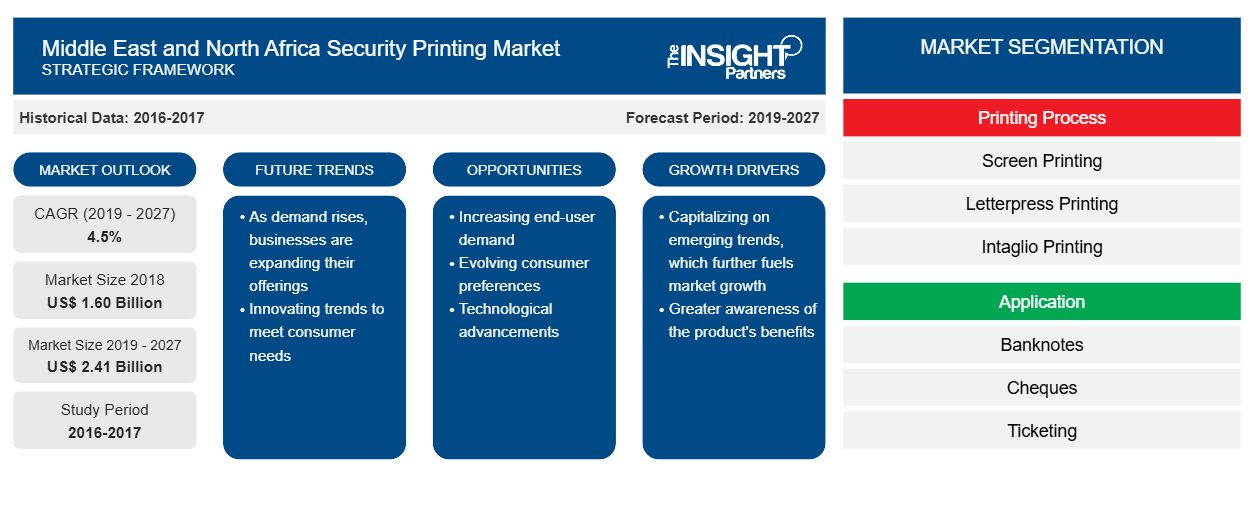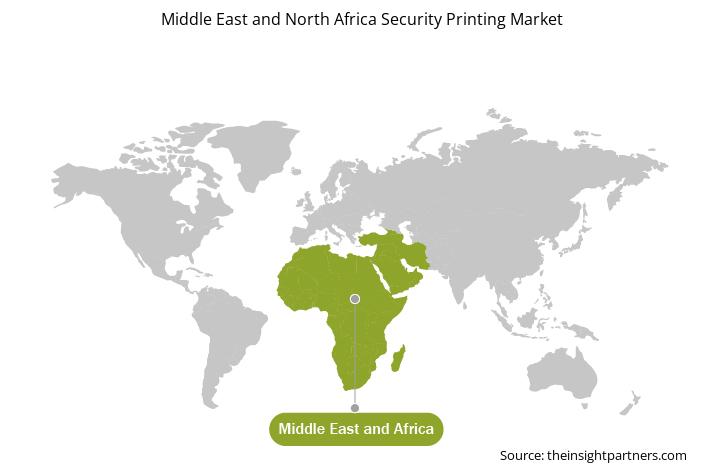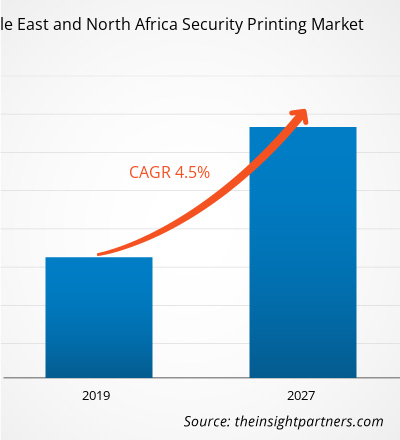The Middle East and North Africa (MENA) security printing market was valued US$ 1.60 Bn in 2018 and is expected to reach US$ 2.41 Bn by 2027 with a CAGR growth rate of 4.5% in the forecast period from 2019 to 2027.
From the past decade, the MENA high-security printing has experienced healthy growth, and the growth is driven by better economic performance, rising incomes, and infrastructure modernization across the region. Counterfeiting practices are particularly spread in banknotes, cheques, ticketing, stamps, payment cards, personal ID, brand protection, and passports applications. Security printing solutions help in the prevention of tampering of various applications; also the security has become the fastest developing and most important technology in the printing industry. The industry does not only secure printed documents, such as banknotes, cheques, and others, but also reduces the risk of increased danger and cost of counterfeiting and forgery. Security printing solutions reduces the production of counterfeit currency and security documents across the MENA region. The Saudi Arabia security printing market is expeted to witness an CAGR growth rate of 3.9% from 2019 to 2027.
MENA Security Printing Market – By Countries

- This FREE sample will include data analysis, ranging from market trends to estimates and forecasts.
- This FREE sample will include data analysis, ranging from market trends to estimates and forecasts.
MENA Security Printing Market Insights
Increased Awareness Regarding Measures to Safeguard Personal Information
Security printing techniques are highly preferred to be used in documents that carry confidential information regarding an individual. During recent years, the use of materials such as e-passports and national ID cards has increased significantly. E-passports, also known as biometric passports, include a chip that can be used at the automated e-passport gates. The embodied chip holds similar information, which is printed on the passport's data page. E-passports are designed in a manner to increase security, which makes it more challenging to alter the data recorded on a passport and hence limiting the chance of fraud. Thus, driving the growth of the security printing market during the coming years.
Rise in the Incidences of Bank Forgeries
Financial fraud is among the most commonly faced issue among financial institutions, including banks present across the globe. The malpractice causes significant losses and depletion of wealth and assets. Financial fraud also hurts the reputation of a concerned institution, its competitiveness, and the economic value. Most of the cases can be due to the adoption of modern technology and advanced communication, such as the wireless mode since they are used by fraudsters to carry their operations and help them to improvise their skills and competences in connection with committing fraud. Thus, growing demand to prevent bank forgeries continue drive the growth of security printing market across the MENA region.
MENA Security Printing Market – Printing Process Insights
Process printing a process of making reproductions of a colored picture by utilizing four halftone plates in red, yellow, blue, and usually black for different colored inks. There are different types of printing processes. The primary printing processes are offset lithography, engraving, thermography, reprographics, digital printing, letterpress, screen, flexography, and gravure. Almost every commercial printer uses offset lithography; it is the workhorse of printing. However, the quality of the final product is usually due to the guidance, expertise, and equipment provided by the printer. The MENA Security Printing Market, based on printing process is segmented into screen printing, letterpress printing, intaglio printing, digital printing, and others.
MENA Security Printing Market – Application Insights
Security printing market, based on application was segmented into banknotes, cheques, ticketing, stamps, payment cards, personal id, brand protection, and passports. In 2018, the banknotes segment held the largest share of the market, by application. However, stamps segment is expected to grow at the fastest rate during the coming years owing to their growing demand from different industry verticals. Thus, stamps are expected to witness a surge in market demand.
MENA Security Printing Market -
Customize This Report To Suit Your Requirement
You will get customization on any report - free of charge - including parts of this report, or country-level analysis, Excel Data pack, as well as avail great offers and discounts for start-ups & universities
Middle East and North Africa Security Printing Market: Strategic Insights

- Get Top Key Market Trends of this report.This FREE sample will include data analysis, ranging from market trends to estimates and forecasts.
You will get customization on any report - free of charge - including parts of this report, or country-level analysis, Excel Data pack, as well as avail great offers and discounts for start-ups & universities
Middle East and North Africa Security Printing Market: Strategic Insights

- Get Top Key Market Trends of this report.This FREE sample will include data analysis, ranging from market trends to estimates and forecasts.
Some of the market initiatives were observed to be most adopted strategy in the MENA security printing market. Few of the recent market initiatives adopted by the market players operating in the security printing market are listed below:
2018:
Along with the Iraqi Ministry of Interior, Veridos is building a new identity document factory in the Republic of Iraq.2017:
The Republic of Zambia contracts Veridos to deliver polycarbonate electronic ID cards to Zambia. The new eID card, which is equipped with a contactless chip, fulfils the highest quality standards and offers convenient multi-application options to Zambian citizens.2016:
The Hashemite Kingdom of Jordan has awarded Veridos a contract to produce and deliver its passports for the next few years.MENA SECURITY PRINTING MARKET SEGMENTATION
MENA Security Printing Market – By Printing Process
- Screen Printing
- Letterpress Printing
- Intaglio Printing
- Digital Printing
- Others
MENA Security Printing Market – By Application
- Banknotes
- Cheques
- Ticketing
- Stamps
- Payment Cards
- Personal ID
- Brand Protection
- Passports
MENA Security Printing Market – By Countries
- Saudi Arabia
- Egypt
- UAE
- Bahrain
- Oman
- Kuwait
- Jordan
- Lebanon
- Iraq
- Rest of MENA
MENA Security Printing Market - Company Profiles
- JMBR Group
- Oumolat Security Printing LLC
- United Security Printing
- Al Ghurair Printing & Publishing LLC (AGPP)
- Al Madina Development & Supply LLC (ADS)
- Alpha Ink & Printing Materials Trading Co. L.L.C
- Andrupos
- Emirates German Security Printing L.L.C.
- HP Development Company, L.P.
- Hypertech Holograms L.L.C,
Middle East and North Africa Security Printing Market Regional Insights
The regional trends and factors influencing the Middle East and North Africa Security Printing Market throughout the forecast period have been thoroughly explained by the analysts at Insight Partners. This section also discusses Middle East and North Africa Security Printing Market segments and geography across North America, Europe, Asia Pacific, Middle East and Africa, and South and Central America.

- Get the Regional Specific Data for Middle East and North Africa Security Printing Market
Middle East and North Africa Security Printing Market Report Scope
| Report Attribute | Details |
|---|---|
| Market size in 2018 | US$ 1.60 Billion |
| Market Size by 2027 | US$ 2.41 Billion |
| Global CAGR (2019 - 2027) | 4.5% |
| Historical Data | 2016-2017 |
| Forecast period | 2019-2027 |
| Segments Covered |
By Printing Process
|
| Regions and Countries Covered | Middle East and Africa
|
| Market leaders and key company profiles |
Middle East and North Africa Security Printing Market Players Density: Understanding Its Impact on Business Dynamics
The Middle East and North Africa Security Printing Market is growing rapidly, driven by increasing end-user demand due to factors such as evolving consumer preferences, technological advancements, and greater awareness of the product's benefits. As demand rises, businesses are expanding their offerings, innovating to meet consumer needs, and capitalizing on emerging trends, which further fuels market growth.
Market players density refers to the distribution of firms or companies operating within a particular market or industry. It indicates how many competitors (market players) are present in a given market space relative to its size or total market value.
Major Companies operating in the Middle East and North Africa Security Printing Market are:
- JMBR Group
- Oumolat Security Printing LLC
- United Security Printing
- Al Ghurair Printing & Publishing LLC
Disclaimer: The companies listed above are not ranked in any particular order.

- Get the Middle East and North Africa Security Printing Market top key players overview
- Historical Analysis (2 Years), Base Year, Forecast (7 Years) with CAGR
- PEST and SWOT Analysis
- Market Size Value / Volume - Global, Regional, Country
- Industry and Competitive Landscape
- Excel Dataset
Testimonials
I wish to appreciate your support and the professionalism you displayed in the course of attending to my request for information regarding to infectious disease IVD market in Nigeria. I appreciate your patience, your guidance, and the fact that you were willing to offer a discount, which eventually made it possible for us to close a deal. I look forward to engaging The Insight Partners in the future, all thanks to the impression you have created in me as a result of this first encounter.
DR CHIJIOKE ONYIA, MANAGING DIRECTOR, PineCrest Healthcare Ltd.The Insight Partners delivered insightful, well-structured market research with strong domain expertise. Their team was professional and responsive throughout. The user-friendly website made accessing industry reports seamless. We highly recommend them for reliable, high-quality research services
Yukihiko Adachi CEO, Deep Blue, LLC.Reason to Buy
- Informed Decision-Making
- Understanding Market Dynamics
- Competitive Analysis
- Customer Insights
- Market Forecasts
- Risk Mitigation
- Strategic Planning
- Investment Justification
- Identifying Emerging Markets
- Enhancing Marketing Strategies
- Boosting Operational Efficiency
- Tracking Industry Innovations
- Aligning with Regulatory Trends
Yes! We provide a free sample of the report, which includes Report Scope (Table of Contents), report structure, and selected insights to help you assess the value of the full report. Please click on the "Download Sample" button or contact us to receive your copy.
Absolutely — analyst assistance is part of the package. You can connect with our analyst post-purchase to clarify report insights, methodology or discuss how the findings apply to your business needs.
Once your order is successfully placed, you will receive a confirmation email along with your invoice.
• For published reports: You’ll receive access to the report within 4–6 working hours via a secured email sent to your email.
• For upcoming reports: Your order will be recorded as a pre-booking. Our team will share the estimated release date and keep you informed of any updates. As soon as the report is published, it will be delivered to your registered email.
We offer customization options to align the report with your specific objectives. Whether you need deeper insights into a particular region, industry segment, competitor analysis, or data cut, our research team can tailor the report accordingly. Please share your requirements with us, and we’ll be happy to provide a customized proposal or scope.
The report is available in either PDF format or as an Excel dataset, depending on the license you choose.
The PDF version provides the full analysis and visuals in a ready-to-read format. The Excel dataset includes all underlying data tables for easy manipulation and further analysis.
Please review the license options at checkout or contact us to confirm which formats are included with your purchase.
Our payment process is fully secure and PCI-DSS compliant.
We use trusted and encrypted payment gateways to ensure that all transactions are protected with industry-standard SSL encryption. Your payment details are never stored on our servers and are handled securely by certified third-party processors.
You can make your purchase with confidence, knowing your personal and financial information is safe with us.
Yes, we do offer special pricing for bulk purchases.
If you're interested in purchasing multiple reports, we’re happy to provide a customized bundle offer or volume-based discount tailored to your needs. Please contact our sales team with the list of reports you’re considering, and we’ll share a personalized quote.
Yes, absolutely.
Our team is available to help you make an informed decision. Whether you have questions about the report’s scope, methodology, customization options, or which license suits you best, we’re here to assist. Please reach out to us at sales@theinsightpartners.com, and one of our representatives will get in touch promptly.
Yes, a billing invoice will be automatically generated and sent to your registered email upon successful completion of your purchase.
If you need the invoice in a specific format or require additional details (such as company name, GST, or VAT information), feel free to contact us, and we’ll be happy to assist.
Yes, certainly.
If you encounter any difficulties accessing or receiving your report, our support team is ready to assist you. Simply reach out to us via email or live chat with your order information, and we’ll ensure the issue is resolved quickly so you can access your report without interruption.















The List of Companies
- JMBR Group
- Oumolat Security Printing LLC
- United Security Printing
- Al Ghurair Printing & Publishing LLC
- Al Madina Development & Supply LLC
- Alpha Ink & Printing Materials Trading Co. L.L.C
- Andrupos
- Emirates German Security Printing L.L.C.
- HP Development Company, L.P
- Hypertech Holograms L.L.C






 Get Free Sample For
Get Free Sample For